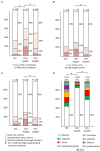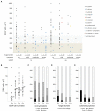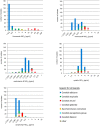Epidemiology and Prevalence of Oral Candidiasis in HIV Patients From Chad in the Post-HAART Era
- PMID: 35250957
- PMCID: PMC8891798
- DOI: 10.3389/fmicb.2022.844069
Epidemiology and Prevalence of Oral Candidiasis in HIV Patients From Chad in the Post-HAART Era
Abstract
Oral candidiasis remains a common problem in HIV-infected individuals, especially in sub-Saharan Africa. Here, we performed the first study in Chad on the prevalence of oral yeasts carriage and oral candidiasis in HIV-positive subjects from southern Chad and analyzed the influence of HAART, CD4+ T-cell numbers, and antimycotics in 589 patients. These patients were recruited from a specialized medical center for HIV patients in Sarh and from a rural medical health dispensary in the vicinity, including a total of 384 HIV-positive and 205 HIV-negative individuals. Yeasts obtained from oral specimen were identified by MALDI-TOF MS and their antifungal susceptibility profiles determined. The overall prevalence of yeast colonization and symptomatic oral candidiasis in HIV-infected patients was 25.1%. The prevalence of oral candidiasis was higher in untreated than in HAART-treated HIV-positive patients (16% vs. 2%; p < 0.01). Oral candidiasis was furthermore associated with high fungal burdens of Candida albicans and a CD4+ T-cell number <200/μl. A shift toward non-albicans Candida species was observed under nucleoside-based HAART therapy. Azole antifungal drug resistance was only observed for the intrinsically resistant species Candida krusei and Candida glabrata. Prevalence of oral candidiasis in the studied area was very low. The species distribution was similar to other countries around the world, with C. albicans being dominant. Candida dubliniensis was not isolated. Nucleoside-based HAART therapy significantly reduced oral colonization as well as occurrence of oral candidiasis caused by C. albicans and led to a species shift toward non-albicans species. Antifungal resistance was not yet a concern in Chad.
Keywords: AIDS; Chad; HIV; NNRIT-HAART; oral Candida colonization.
Copyright © 2022 Taverne-Ghadwal, Kuhns, Buhl, Schulze, Mbaitolum, Kersch, Weig, Bader and Groß.
Conflict of interest statement
UG and OB have received financial support from Pfizer and Astellas Pharma. The remaining authors declare that the research was conducted in the absence of any commercial or financial relationships that could be construed as a potential conflict of interest.
Figures





References
-
- Ambe N. F., Longdoh N. A., Tebid P., Bobga T. P., Nkfusai C. N., Ngwa S. B., et al. . (2020). The prevalence, risk factors and antifungal sensitivity pattern of oral candidiasis in HIV/AIDS patients in Kumba District hospital, south west region, Cameroon. Pan Afr. Med. J. 36:23. doi: 10.11604/pamj.2020.36.23.18202, PMID: - DOI - PMC - PubMed
-
- Bader O., Weig M., Taverne-Ghadwal L., Lugert R., Groß U., Kuhns M. (2011). Improved clinical laboratory identification of human pathogenic yeasts by matrix-assisted laser desorption ionization time-of-flight mass spectrometry. Clin. Microbiol. Infect. 17, 1359–1365. doi: 10.1111/j.1469-0691.2010.03398.x, PMID: - DOI - PubMed
LinkOut - more resources
Full Text Sources
Research Materials

